For this Nikon Z 35mm f/1.8 S test, we will focus on the first of the two fixed focal lengths in the current Nikon Z series. Every new system with a new mount has its new cameras, accompanied by its new lenses.
On the zoom side, it was the Nikon Z 24-70mm f/4sec that had the difficult task of establishing itself as the basic standard. And it does it brilliantly.
In terms of fixed focal lengths to accompany it, Nikon has chosen to offer two (if the very exclusive and exotic Noct-Nikkor Z 58 mm f/0.95 S is deliberately left out.): one 35 mm f/1.8 and one 50 mm f/1.8.
This goal at the best price at Miss Digital
This goal at the best price at Amazon
Two fixed “all-purpose” focal lengths that are very close in spirit, with apertures generous enough to play with depth of field and free yourself from the flash, but not too much either so as not to add to the bill or the photo bag.
The Nikon Z 35mm f/1.8 S is destined to become a classic, both in terms of its focal length, particularly suited to street photography, and its aperture, a little more prestigious than a “simple” f/2, a little less elitist than a “professional” f/1.4.
Of course, it won’t be without reminding you of the Nikon AF-S 35mm f/1.8 G ED, at least in spirit. Because in practice, the 35mm f/1.8 Hybrid has little in common with its DSLR counterpart, starting with price.
While the one in F-mount (reflex) is officially displayed at 549 euros (you will easily find it under 500 euros), his cousin in Z-mount (hybrid) starts his commercial career at 949 euros catalogue price (849 euros commonly seen).
That stings a bit for a goal that is supposed to be “standard” in every sense of the word. This raises only one question: is it justified?

Nikon Z test 35 mm f/1.8 S: ISO 125 – 1/6,400th – f/1.8
Who is this Nikon Z 35 mm f/1.8 S for?
At the time of writing, there are only two fixed focal lengths in Nikon Z-mount (at Nikon): 35mm f/1.8 and 50mm f/1.8. The 35mm f/1.8 is designed for those who want a bright fixed focal length but who would find the 50mm a little too long to prefer the wider angle of view of a 35mm, more versatile in street photography for example, but less suitable for portraiture.
When you put it that way, it sounds a bit like having the choice between vanilla and chocolate flavors for your ice cream, and opting for vanilla because you don’t like chocolate (or vice versa). It’s trivial, but until Nikon enriches their optical offer with fixed lenses, we’ll have to make do with it.
Let’s project ourselves into the future. Starting in 2019, a 28mm f/1.8 and an 85mm f/1.8 will be added to the fixed focal length offering, and in 2020 a 24mm f/1.8 (note the consistency of the f/1.8) and a 50mm f/1.2 will be added (see the updated Nikon Z product plan). If you are reading this test at that time, then the choice of a 35mm will have to be made according to other criteria than the simple default selection.

Nikon Z test 35 mm f/1.8 S: ISO 125 – 1/80th – f/1.8
Question: Why choose a 35 mm? Possible answers:
- because you don’t like the 50mm but you still want a standard “all-purpose” focal length,
- because in the trinity ” wide angle + standard focal length + portrait optics ” the 35 mm fits well between the 21 mm and the 75 mm (in this case the 21 mm and the 85 mm),
- because its angle of view slightly wider than 50 mm allows you to frame a little wider when shooting and crop in post-processing if necessary. And this with a safety margin that’s all the more comfortable if you own a Nikon Z 7 and its 45.7 Mpx.
Well, for the moment, this test has been done on a Nikon Z 6, but 24 Mpx are already enough to support some cropping and straightening of horizontals.
Quality of construction
The Nikon Z 35 mm f/1.8 S benefits from exactly the same quality of construction as the Nikon Z 24-70 mm f/4 S and Nikon Z 50 mm f/1.8 S. Everyone is in the same boat, so there’s no need to be jealous. Hop!
Of course, since it is a fixed focal length, you lose the zoom ring and the focus lock (logical) but, instead, you get a giant, nicely grooved, fluid focus ring… and no stop. This benefits the electronic steering but clearly detracts from the tactile pleasure.
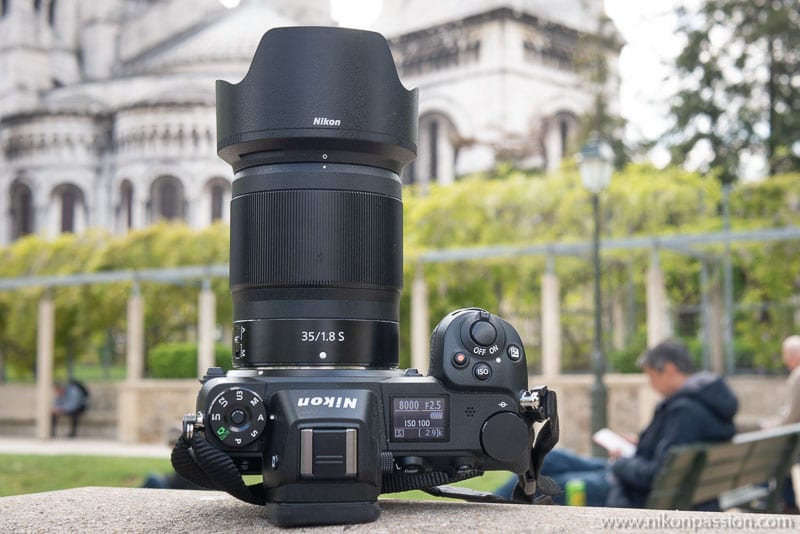
The barrel is matt black, the rubber ring, the whole benefits from seals preventing water and dust infiltration inside the lens and even at the level of the mount. Well done!
Both serious and sober, the Nikon Z 35mm f/1.8 S has what it takes to inspire confidence and what it takes to be critically challenged. For example, you can criticize its lack of distance graduation, its lack of opening ring, its lack of stabilization…
However, don’t be fooled by its seeming exterior sobriety and false similarities to the AF-S Nikkor 35mm f/1.8 G ED. With its optical formula of 11 lenses (two ED glass and three aspherical) in 9 groups, the use of nanocrystal and fluorine coatings, and a 9-blade circular electromagnetic diaphragm, the Nikon Z 35mm f/1.8 S is far more modern in design than its SLR alter-ego, and even more ambitious than the AF-S Nikkor 35mm f/1.4 G!
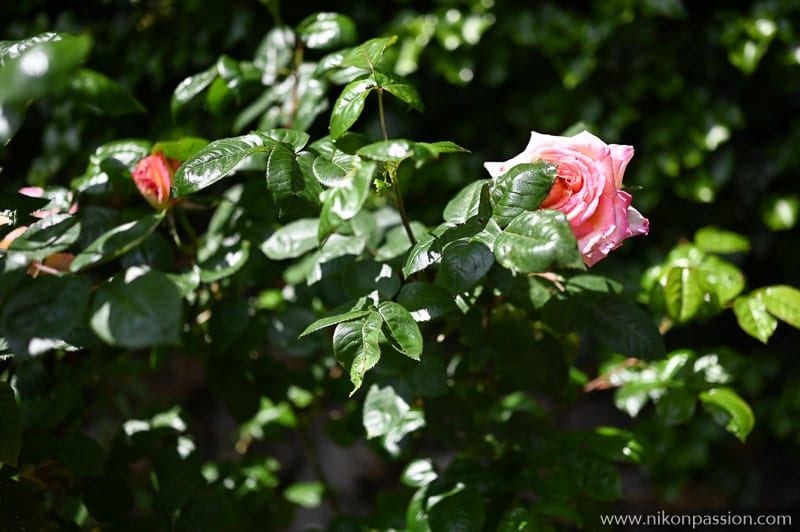
Nikon Z test 35 mm f/1.8 S: ISO 100 – 1/2,500th – f/1.8
Note, by the way, that the minimum focus is at 25 cm, which allows nice close-up shots with a very short depth of field.
Handling and autofocus
With 73mm diameter and 86mm length (excluding lens hood) the Nikon Z 35mm f/1.8 S is really bulky for this type of focal length and aperture. Luckily, at only 370 grams, it won’t weigh too much in your camera bag and won’t prick your body from the nose when mounted on it.
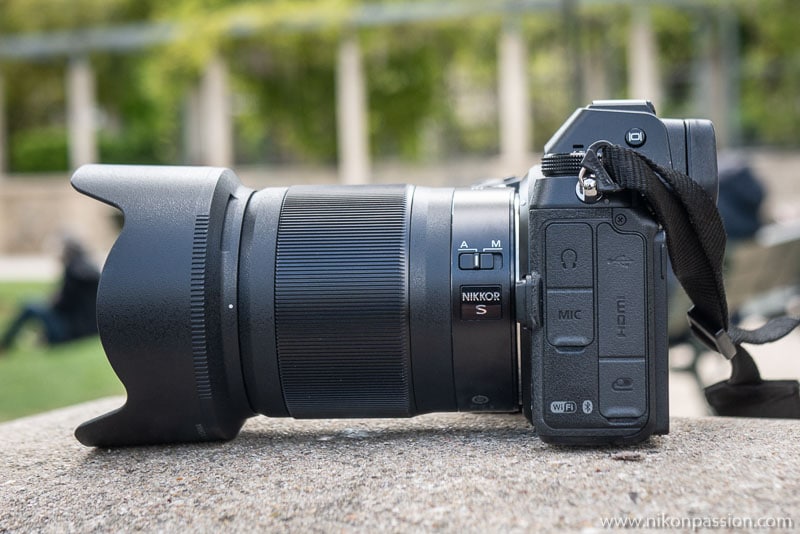
Its generous dimensions make it easy to grip, suitable for all templates, and apart from playing with the focus ring and AF/MF switch, the left hand won’t have much to do.
The autofocus motorization is as precise as it is quiet. Nikon knows and masters its score, nothing to report on this side. That’s a good sign. So we can continue with peace of mind.
Stabilization
Since Nikon Z hybrids feature mechanically stabilized sensors, Nikon didn’t consider it useful to provide its lenses with Z-mount (logical). The Nikon Z 35mm f/1.8 S is no exception. That said, with its aperture and still short focal length combined with the excellent high-sensitivity capabilities of the Z 6 and Z 7, you can photograph with peace of mind in poor lighting conditions without worrying too much about blurred movement.
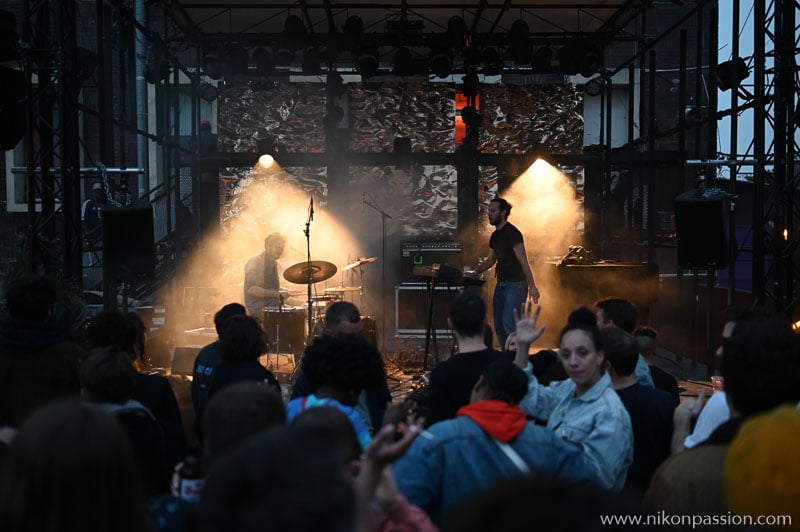
Nikon Z test 35 mm f/1.8 S: ISO 1.600 – 1/500th – f/1.8
Optical performance: vignetting
Like the Nikon Z 24-70mm f/4 S, the Nikon Z 35mm f/1.8 S easily captures images at its largest apertures (f/1.8 to f/2.8). Nikon has therefore clearly chosen to exploit the communication speed of its Z-mount to let the camera body electronically correct lens defects.
I don’t see why not. Still, if you’re allergic to vignetting, don’t uncheck the auto-correction option (enabled by default), especially if you shoot mostly in JPEG.
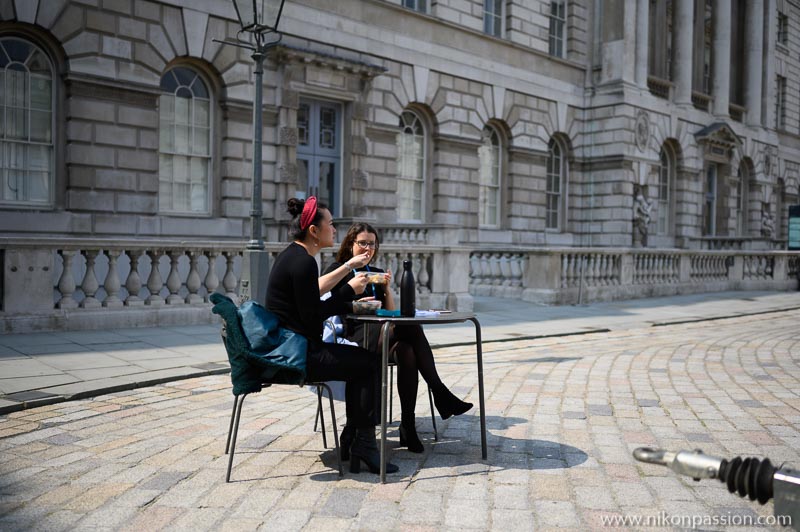
Nikon Z test 35 mm f/1.8 S: ISO 125 – 1/5,000th – f/1.8
Optical performance: deformation and distortion
The 35mm focal length is not really subject to distortion or deformation. With its armada of aspherical lenses and complex optical formula, the Nikon Z 35mm f/1.8 S does a good job of it. Especially since, in any case, it is not possible to disable the automatic correction of distortion in the body …
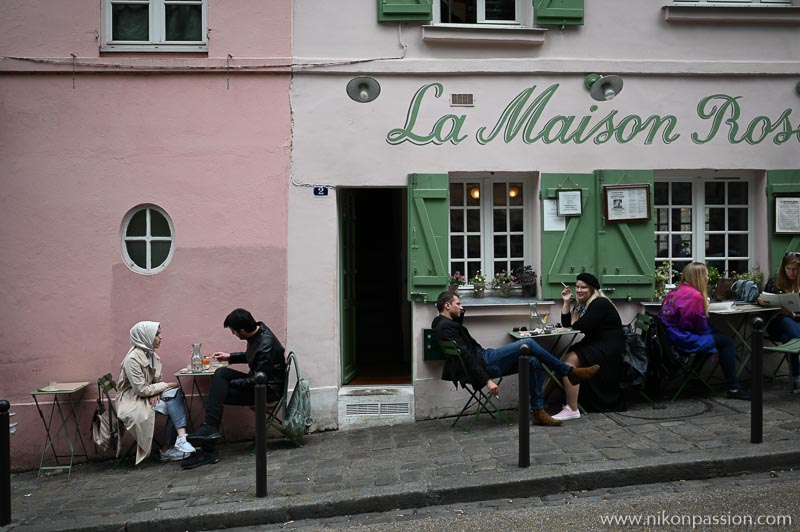
Nikon Z test 35 mm f/1.8 S: ISO 100 – 1/1,000th – f/2
Optical performance: sharpness, homogeneity and flare
What distinguishes a luminous fixed focal length from a very good luminous fixed focal length? Its ability (or not) to reach its full potential at the widest aperture. So what category does the Nikon Z 35mm f/1.8 S fall into? Is its f/1.8 just there to save the day when light is lacking, or can it really be used in all circumstances, without any ulterior motives?
The good news is that this 35mm f/1.8 belongs to the second category, that of luminous fixed focal lengths that aren’t just for show. However, it’s not without flaws.

Nikon Z test 35 mm f/1.8 S: ISO 10,000 – 1/80th – f/1.8
If the dive in the centre is very satisfactory from f/1.8, to become very good at f/2.8, it will be necessary to close up to f/8 so that the lens shows almost perfect homogeneity, with corners at the same level as the centre.
Now, that’s just a matter of quibbling and splitting hairs. Once again, in real life, unless you’re only photographing flat objects perfectly from the front (which is the case if you’re a specialist in reprography or art photography), this slight lack of homogeneity of the Nikon Z 35mm f/1.8 S won’t be a problem.
A word of warning: there simply aren’t any, unless you really want to do it on purpose. But in the overwhelming majority of cases, it must be said that the nano-crystal treatment works miracles and the Nikon Z 35 mm f/1.8 S is able to get out of high-contrast, front lighting situations with disconcerting ease.
Optical performance: color rendering and chromatic aberrations
To bring perfect consistency to the range, the Nikon Z 35mm f/1.8 S plays exactly the same score as the Nikon Z 24-70mm f/4 S in terms of colour rendering: it’s neutral, it’s clean, nothing out of place.
The same goes for chromatic aberrations: muzzled, absent subscribers. In short, if you like surgical objectives, you will be fulfilled. Others will find it without soul or character. History of aesthetic expectations and philosophical point of view…
Optical rendering: depth of field
With the combination of a 24 x 36 mm sensor, an f/1.8 aperture, a 9-blade diaphragm, a minimum focus at 25 cm and a standard focal length, there should be a way to achieve shallow depths of field and good separation of the subject from its background, even without having to stick to it.
When it comes to bokeh, the Nikon Z 35 mm f/1.8 S delivers on all its promises: it’s soft, it’s almost velvety, but, in keeping with the rest of the aesthetic signature, it’s still very neutral.

Nikon Z test 35 mm f/1.8 S: ISO 100 – 1/125th – f/1.8
Of course, you shouldn’t expect “quarter-hair” depth-of-field effects since after all it is “only” a 35 mm, but compared to the Nikon Z 24-70 mm f/4 S the playing latitude is appreciable.
And, above all, remember that at f/1.8, you gain a little more than two f-stops compared to f/4, which in terms of shutter speed can make all the difference, especially in the middle of the night!
The Nikon Z 35 mm f/1.8 S may be of interest to you if…
- you want to complete your 24-70 mm f/4 kit zoom lens with a fixed focal length that is bright enough for everything,
- you’re a big fan of street photography,
- you appreciate the versatility of a 35mm, as capable in landscape as in reportage, with a few forays into portrait,
- you find the 50 mm a little too long and tight,
- you plan to combine it with the future Nikon Z 20 mm f/1.8 S.
The Nikon Z 35 mm f/1.8 S will be of less interest to you if…
- you are looking for a lens capable of providing a very shallow depth of field,
- you like lenses with a strong aesthetic character,
- you already own the Nikon Z 50 mm f/1.8 S with which it may be duplicated.
Any photographic system must have a 35 mm and 50 mm (or equivalents), rather bright, versatile, able to accompany you in landscape and street photography, to photograph flowers floating in the wind or children running around. And, just as well, Nikon decided to launch its Z hybrid system with a 35mm f/1.8 and 50mm f/1.8.
But why this slightly bastard opening of f/1.8? I’ll get back to that. For now, what did I think of this Nikon Z 35 mm f/1.8 S?
Objectively, it is a good objective, difficult to deny it. Seriously built, with many seals even at the mount level, its autofocus is fast, silent, precise, in a word efficient. The center of the lens is well pricked as soon as the full aperture is reached, and its slight lack of homogeneity is not alarming. It will go unnoticed in most cases.
There is no distortion or distortion, only vignetting between f/1.8 and f/2.8 shades the picture – and even then, its automatic correction by the body will make it unnoticeable. The colours? Neutral, clean, no fuss, and even commentary on the bokeh.
To sum up: the Nikon Z 35mm f/1.8 S is a clean standard focal length on it. Nikon’s engineers prove that they have mastered their subject well and have made no missteps. Good!

Nikon Z test 35 mm f/1.8 S: ISO 100 – 1/1.250 ème – f/1.8
Yet why the small accent of disappointment in this conclusion? It’s because, subjectively, the Nikon Z 35 mm f/1.8 S leaves a taste of not enough, especially considering the 949 euros Nikon is asking for to make it its own. Its aesthetic, surgical neutrality has an insipid side that, while it certainly fits the times, does not really distinguish it from the other 35 mm f/1.8.
This is a pragmatic objective, not a crush. Above all, its very good quality of construction underlines, paradoxically, its ergonomic poverty: ” All this for a big cylinder of almost fifteen centimeters (with the sun visor), with just a big rubber ring to break the monotony? Well, you have to like the Japanese skinning. »
As a fixed focal length lens, it would have been nice to have a little more to put under the tooth: a distance scale, focus stops, let’s be crazy, a dedicated (and detachable) diaphragm ring! Something that makes you want to manipulate the lens as a photographic object that you are proud to own, and not just a side-kick to your camera body for which, on the contrary, ergonomics and tactile pleasure have been particularly worked on.
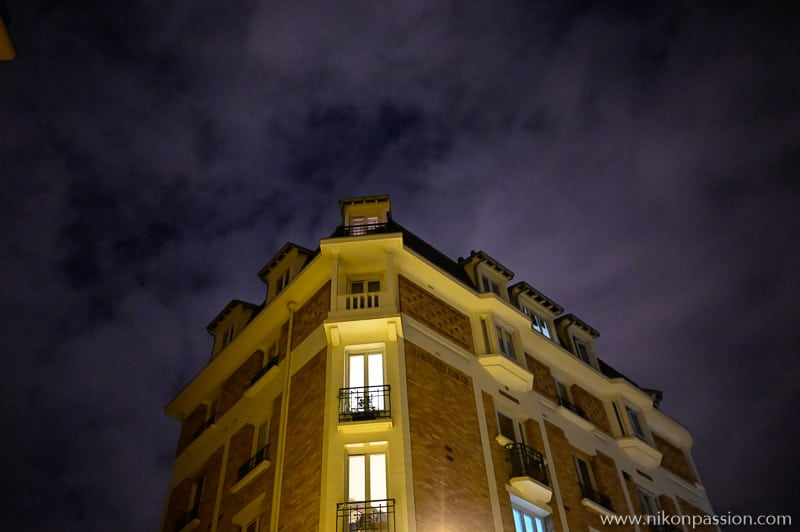
Nikon Z test 35 mm f/1.8 S: ISO 10,000 – 1/60th – f/1.8
In short, by positioning itself so high from a price point of view, with such a neutral rendering and such uncluttered ergonomics, the Nikon Z 35 mm f/1.8 S leaves the field open for third party opticians to come and titillate it on their own turf. Either with a more attractive tariff (Sigma cuckoo clock), or with a stabilization (Tamron cuckoo clock), or with a more marked rendering (Samyang cuckoo clock), or with a more furnished ergonomics, or with all this at the same time.
In short, unless you’re madly in love with 35mm lenses, need a large aperture and want one absolutely right now, right now, I would recommend that you wait a bit and see what Nikon and/or the competition will offer in the future on this lens.
Click on the picture below to see the photos taken for this test in full definition :
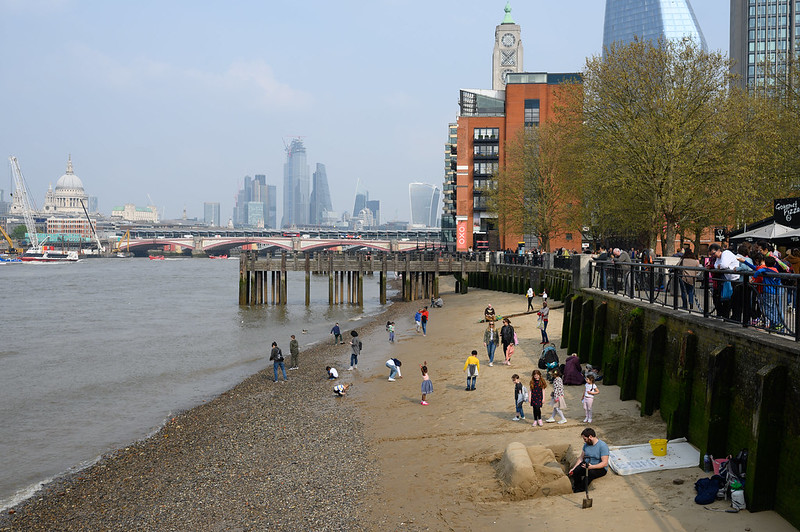
To wrap up that question, I promised to answer the question ” why f/1.8? “, which implies ” why not f/1.4 or f/2? ».
The answer is quite simple, but it deserves to be put down in black and white. From a photometric point of view, switching to f/1.4 rather than f/1.8 would certainly save 2/3 f-stop, but given the excellent high-sensitivity capabilities of the Nikon Z 6 and Z 7, it is more practical to compensate for this lack of brightness on the aperture side with higher ISOs.
Still from a photometric point of view, there is no real interest in preferring an f/1.8 rather than an f/2, since there is only a third of a diaphragm difference, but an aperture in “f/1,something”, psychologically, it remains more selling.
From a practical point of view, opting for f/1.8 allows you to have a smaller and lighter lens than an f/1.4 (especially since it is already rather bulky), and above all less expensive! Looking at the SLR range, the 35mm f/1.4 is three times more expensive than the f/1.8!
Nikon was therefore right to focus on a more “reasonable” aperture, and to go for the optical formula.
Finally, from the point of view of positioning in the range, two things.
First of all, a 35 mm f/1.8, that leaves enough room for a possible Nikon Z 35 mm f/2.8 S which, if it is not foreseen by the current roadmap, would easily find a buyer as long as it combines good optical performance, great compactness and attractive price (no more than 380/420 euros). In fact, something in line with the Sony Zeiss Sonnar T* FE 35 mm f/2.8 ZA that exists for the Sony Alpha 7/9.
Second aspect: it is obvious that Nikon has the ambition to build a line of coherent fixed focal lengths all sharing the same aperture. F/2 would have been the simplest choice to go from 20mm to 85mm: f/1.8 sends the message that Nikon is more ambitious than the obvious, that it masters its subject in terms of optics, while at the same time having the wisdom and pragmatism not to go into the delirium of f/1.4 which would impose lenses that are far too expensive, heavy and difficult to conceive – in fact, the exact opposite of what Canon is setting up with its EOS R line.
But that doesn’t change the fact that the Nikon Z 35mm f/1.8 S lacks panache, however good it is.
Complete presentation and technical data sheet on the Nikon website
This goal at the best price at Miss Digital
This goal at the best price at Amazon
For this Nikon Z 35mm f/1.8 S test, we will focus on the first of the two fixed focal lengths in the current Nikon Z series. Every new system with a new mount has its new cameras, accompanied by its new lenses.
On the zoom side, it was the Nikon Z 24-70mm f/4sec that had the difficult task of establishing itself as the basic standard. And it does it brilliantly.
In terms of fixed focal lengths to accompany it, Nikon has chosen to offer two (if the very exclusive and exotic Noct-Nikkor Z 58 mm f/0.95 S is deliberately left out.): one 35 mm f/1.8 and one 50 mm f/1.8.
This goal at the best price at Miss Digital
This goal at the best price at Amazon
Two fixed “all-purpose” focal lengths that are very close in spirit, with apertures generous enough to play with depth of field and free yourself from the flash, but not too much either so as not to add to the bill or the photo bag.
The Nikon Z 35mm f/1.8 S is destined to become a classic, both in terms of its focal length, particularly suited to street photography, and its aperture, a little more prestigious than a “simple” f/2, a little less elitist than a “professional” f/1.4.
Of course, it won’t be without reminding you of the Nikon AF-S 35mm f/1.8 G ED, at least in spirit. Because in practice, the 35mm f/1.8 Hybrid has little in common with its DSLR counterpart, starting with price.
While the one in F-mount (reflex) is officially displayed at 549 euros (you will easily find it under 500 euros), his cousin in Z-mount (hybrid) starts his commercial career at 949 euros catalogue price (849 euros commonly seen).
That stings a bit for a goal that is supposed to be “standard” in every sense of the word. This raises only one question: is it justified?

Nikon Z test 35 mm f/1.8 S: ISO 125 – 1/6,400th – f/1.8
Who is this Nikon Z 35 mm f/1.8 S for?
At the time of writing, there are only two fixed focal lengths in Nikon Z-mount (at Nikon): 35mm f/1.8 and 50mm f/1.8. The 35mm f/1.8 is designed for those who want a bright fixed focal length but who would find the 50mm a little too long to prefer the wider angle of view of a 35mm, more versatile in street photography for example, but less suitable for portraiture.
When you put it that way, it sounds a bit like having the choice between vanilla and chocolate flavors for your ice cream, and opting for vanilla because you don’t like chocolate (or vice versa). It’s trivial, but until Nikon enriches their optical offer with fixed lenses, we’ll have to make do with it.
Let’s project ourselves into the future. Starting in 2019, a 28mm f/1.8 and an 85mm f/1.8 will be added to the fixed focal length offering, and in 2020 a 24mm f/1.8 (note the consistency of the f/1.8) and a 50mm f/1.2 will be added (see the updated Nikon Z product plan). If you are reading this test at that time, then the choice of a 35mm will have to be made according to other criteria than the simple default selection.

Nikon Z test 35 mm f/1.8 S: ISO 125 – 1/80th – f/1.8
Question: Why choose a 35 mm? Possible answers:
- because you don’t like the 50mm but you still want a standard “all-purpose” focal length,
- because in the trinity ” wide angle + standard focal length + portrait optics ” the 35 mm fits well between the 21 mm and the 75 mm (in this case the 21 mm and the 85 mm),
- because its angle of view slightly wider than 50 mm allows you to frame a little wider when shooting and crop in post-processing if necessary. And this with a safety margin that’s all the more comfortable if you own a Nikon Z 7 and its 45.7 Mpx.
Well, for the moment, this test has been done on a Nikon Z 6, but 24 Mpx are already enough to support some cropping and straightening of horizontals.
Quality of construction
The Nikon Z 35 mm f/1.8 S benefits from exactly the same quality of construction as the Nikon Z 24-70 mm f/4 S and Nikon Z 50 mm f/1.8 S. Everyone is in the same boat, so there’s no need to be jealous. Hop!
Of course, since it is a fixed focal length, you lose the zoom ring and the focus lock (logical) but, instead, you get a giant, nicely grooved, fluid focus ring… and no stop. This benefits the electronic steering but clearly detracts from the tactile pleasure.

The barrel is matt black, the rubber ring, the whole benefits from seals preventing water and dust infiltration inside the lens and even at the level of the mount. Well done!
Both serious and sober, the Nikon Z 35mm f/1.8 S has what it takes to inspire confidence and what it takes to be critically challenged. For example, you can criticize its lack of distance graduation, its lack of opening ring, its lack of stabilization…
However, don’t be fooled by its seeming exterior sobriety and false similarities to the AF-S Nikkor 35mm f/1.8 G ED. With its optical formula of 11 lenses (two ED glass and three aspherical) in 9 groups, the use of nanocrystal and fluorine coatings, and a 9-blade circular electromagnetic diaphragm, the Nikon Z 35mm f/1.8 S is far more modern in design than its SLR alter-ego, and even more ambitious than the AF-S Nikkor 35mm f/1.4 G!

Nikon Z test 35 mm f/1.8 S: ISO 100 – 1/2,500th – f/1.8
Note, by the way, that the minimum focus is at 25 cm, which allows nice close-up shots with a very short depth of field.
Handling and autofocus
With 73mm diameter and 86mm length (excluding lens hood) the Nikon Z 35mm f/1.8 S is really bulky for this type of focal length and aperture. Luckily, at only 370 grams, it won’t weigh too much in your camera bag and won’t prick your body from the nose when mounted on it.

Its generous dimensions make it easy to grip, suitable for all templates, and apart from playing with the focus ring and AF/MF switch, the left hand won’t have much to do.
The autofocus motorization is as precise as it is quiet. Nikon knows and masters its score, nothing to report on this side. That’s a good sign. So we can continue with peace of mind.
Stabilization
Since Nikon Z hybrids feature mechanically stabilized sensors, Nikon didn’t consider it useful to provide its lenses with Z-mount (logical). The Nikon Z 35mm f/1.8 S is no exception. That said, with its aperture and still short focal length combined with the excellent high-sensitivity capabilities of the Z 6 and Z 7, you can photograph with peace of mind in poor lighting conditions without worrying too much about blurred movement.

Nikon Z test 35 mm f/1.8 S: ISO 1.600 – 1/500th – f/1.8
Optical performance: vignetting
Like the Nikon Z 24-70mm f/4 S, the Nikon Z 35mm f/1.8 S easily captures images at its largest apertures (f/1.8 to f/2.8). Nikon has therefore clearly chosen to exploit the communication speed of its Z-mount to let the camera body electronically correct lens defects.
I don’t see why not. Still, if you’re allergic to vignetting, don’t uncheck the auto-correction option (enabled by default), especially if you shoot mostly in JPEG.

Nikon Z test 35 mm f/1.8 S: ISO 125 – 1/5,000th – f/1.8
Optical performance: deformation and distortion
The 35mm focal length is not really subject to distortion or deformation. With its armada of aspherical lenses and complex optical formula, the Nikon Z 35mm f/1.8 S does a good job of it. Especially since, in any case, it is not possible to disable the automatic correction of distortion in the body …

Nikon Z test 35 mm f/1.8 S: ISO 100 – 1/1,000th – f/2
Optical performance: sharpness, homogeneity and flare
What distinguishes a luminous fixed focal length from a very good luminous fixed focal length? Its ability (or not) to reach its full potential at the widest aperture. So what category does the Nikon Z 35mm f/1.8 S fall into? Is its f/1.8 just there to save the day when light is lacking, or can it really be used in all circumstances, without any ulterior motives?
The good news is that this 35mm f/1.8 belongs to the second category, that of luminous fixed focal lengths that aren’t just for show. However, it’s not without flaws.

Nikon Z test 35 mm f/1.8 S: ISO 10,000 – 1/80th – f/1.8
If the dive in the centre is very satisfactory from f/1.8, to become very good at f/2.8, it will be necessary to close up to f/8 so that the lens shows almost perfect homogeneity, with corners at the same level as the centre.
Now, that’s just a matter of quibbling and splitting hairs. Once again, in real life, unless you’re only photographing flat objects perfectly from the front (which is the case if you’re a specialist in reprography or art photography), this slight lack of homogeneity of the Nikon Z 35mm f/1.8 S won’t be a problem.
A word of warning: there simply aren’t any, unless you really want to do it on purpose. But in the overwhelming majority of cases, it must be said that the nano-crystal treatment works miracles and the Nikon Z 35 mm f/1.8 S is able to get out of high-contrast, front lighting situations with disconcerting ease.
Optical performance: color rendering and chromatic aberrations
To bring perfect consistency to the range, the Nikon Z 35mm f/1.8 S plays exactly the same score as the Nikon Z 24-70mm f/4 S in terms of colour rendering: it’s neutral, it’s clean, nothing out of place.
The same goes for chromatic aberrations: muzzled, absent subscribers. In short, if you like surgical objectives, you will be fulfilled. Others will find it without soul or character. History of aesthetic expectations and philosophical point of view…
Optical rendering: depth of field
With the combination of a 24 x 36 mm sensor, an f/1.8 aperture, a 9-blade diaphragm, a minimum focus at 25 cm and a standard focal length, there should be a way to achieve shallow depths of field and good separation of the subject from its background, even without having to stick to it.
When it comes to bokeh, the Nikon Z 35 mm f/1.8 S delivers on all its promises: it’s soft, it’s almost velvety, but, in keeping with the rest of the aesthetic signature, it’s still very neutral.

Nikon Z test 35 mm f/1.8 S: ISO 100 – 1/125th – f/1.8
Of course, you shouldn’t expect “quarter-hair” depth-of-field effects since after all it is “only” a 35 mm, but compared to the Nikon Z 24-70 mm f/4 S the playing latitude is appreciable.
And, above all, remember that at f/1.8, you gain a little more than two f-stops compared to f/4, which in terms of shutter speed can make all the difference, especially in the middle of the night!
The Nikon Z 35 mm f/1.8 S may be of interest to you if…
- you want to complete your 24-70 mm f/4 kit zoom lens with a fixed focal length that is bright enough for everything,
- you’re a big fan of street photography,
- you appreciate the versatility of a 35mm, as capable in landscape as in reportage, with a few forays into portrait,
- you find the 50 mm a little too long and tight,
- you plan to combine it with the future Nikon Z 20 mm f/1.8 S.
The Nikon Z 35 mm f/1.8 S will be of less interest to you if…
- you are looking for a lens capable of providing a very shallow depth of field,
- you like lenses with a strong aesthetic character,
- you already own the Nikon Z 50 mm f/1.8 S with which it may be duplicated.
Any photographic system must have a 35 mm and 50 mm (or equivalents), rather bright, versatile, able to accompany you in landscape and street photography, to photograph flowers floating in the wind or children running around. And, just as well, Nikon decided to launch its Z hybrid system with a 35mm f/1.8 and 50mm f/1.8.
But why this slightly bastard opening of f/1.8? I’ll get back to that. For now, what did I think of this Nikon Z 35 mm f/1.8 S?
Objectively, it is a good objective, difficult to deny it. Seriously built, with many seals even at the mount level, its autofocus is fast, silent, precise, in a word efficient. The center of the lens is well pricked as soon as the full aperture is reached, and its slight lack of homogeneity is not alarming. It will go unnoticed in most cases.
There is no distortion or distortion, only vignetting between f/1.8 and f/2.8 shades the picture – and even then, its automatic correction by the body will make it unnoticeable. The colours? Neutral, clean, no fuss, and even commentary on the bokeh.
To sum up: the Nikon Z 35mm f/1.8 S is a clean standard focal length on it. Nikon’s engineers prove that they have mastered their subject well and have made no missteps. Good!

Nikon Z test 35 mm f/1.8 S: ISO 100 – 1/1.250 ème – f/1.8
Yet why the small accent of disappointment in this conclusion? It’s because, subjectively, the Nikon Z 35 mm f/1.8 S leaves a taste of not enough, especially considering the 949 euros Nikon is asking for to make it its own. Its aesthetic, surgical neutrality has an insipid side that, while it certainly fits the times, does not really distinguish it from the other 35 mm f/1.8.
This is a pragmatic objective, not a crush. Above all, its very good quality of construction underlines, paradoxically, its ergonomic poverty: ” All this for a big cylinder of almost fifteen centimeters (with the sun visor), with just a big rubber ring to break the monotony? Well, you have to like the Japanese skinning. »
As a fixed focal length lens, it would have been nice to have a little more to put under the tooth: a distance scale, focus stops, let’s be crazy, a dedicated (and detachable) diaphragm ring! Something that makes you want to manipulate the lens as a photographic object that you are proud to own, and not just a side-kick to your camera body for which, on the contrary, ergonomics and tactile pleasure have been particularly worked on.

Nikon Z test 35 mm f/1.8 S: ISO 10,000 – 1/60th – f/1.8
In short, by positioning itself so high from a price point of view, with such a neutral rendering and such uncluttered ergonomics, the Nikon Z 35 mm f/1.8 S leaves the field open for third party opticians to come and titillate it on their own turf. Either with a more attractive tariff (Sigma cuckoo clock), or with a stabilization (Tamron cuckoo clock), or with a more marked rendering (Samyang cuckoo clock), or with a more furnished ergonomics, or with all this at the same time.
In short, unless you’re madly in love with 35mm lenses, need a large aperture and want one absolutely right now, right now, I would recommend that you wait a bit and see what Nikon and/or the competition will offer in the future on this lens.
Click on the picture below to see the photos taken for this test in full definition :

To wrap up that question, I promised to answer the question ” why f/1.8? “, which implies ” why not f/1.4 or f/2? ».
The answer is quite simple, but it deserves to be put down in black and white. From a photometric point of view, switching to f/1.4 rather than f/1.8 would certainly save 2/3 f-stop, but given the excellent high-sensitivity capabilities of the Nikon Z 6 and Z 7, it is more practical to compensate for this lack of brightness on the aperture side with higher ISOs.
Still from a photometric point of view, there is no real interest in preferring an f/1.8 rather than an f/2, since there is only a third of a diaphragm difference, but an aperture in “f/1,something”, psychologically, it remains more selling.
From a practical point of view, opting for f/1.8 allows you to have a smaller and lighter lens than an f/1.4 (especially since it is already rather bulky), and above all less expensive! Looking at the SLR range, the 35mm f/1.4 is three times more expensive than the f/1.8!
Nikon was therefore right to focus on a more “reasonable” aperture, and to go for the optical formula.
Finally, from the point of view of positioning in the range, two things.
First of all, a 35 mm f/1.8, that leaves enough room for a possible Nikon Z 35 mm f/2.8 S which, if it is not foreseen by the current roadmap, would easily find a buyer as long as it combines good optical performance, great compactness and attractive price (no more than 380/420 euros). In fact, something in line with the Sony Zeiss Sonnar T* FE 35 mm f/2.8 ZA that exists for the Sony Alpha 7/9.
Second aspect: it is obvious that Nikon has the ambition to build a line of coherent fixed focal lengths all sharing the same aperture. F/2 would have been the simplest choice to go from 20mm to 85mm: f/1.8 sends the message that Nikon is more ambitious than the obvious, that it masters its subject in terms of optics, while at the same time having the wisdom and pragmatism not to go into the delirium of f/1.4 which would impose lenses that are far too expensive, heavy and difficult to conceive – in fact, the exact opposite of what Canon is setting up with its EOS R line.
But that doesn’t change the fact that the Nikon Z 35mm f/1.8 S lacks panache, however good it is.
Complete presentation and technical data sheet on the Nikon website
This goal at the best price at Miss Digital
This goal at the best price at Amazon
For this Nikon Z 35mm f/1.8 S test, we will focus on the first of the two fixed focal lengths in the current Nikon Z series. Every new system with a new mount has its new cameras, accompanied by its new lenses.
On the zoom side, it was the Nikon Z 24-70mm f/4sec that had the difficult task of establishing itself as the basic standard. And it does it brilliantly.
In terms of fixed focal lengths to accompany it, Nikon has chosen to offer two (if the very exclusive and exotic Noct-Nikkor Z 58 mm f/0.95 S is deliberately left out.): one 35 mm f/1.8 and one 50 mm f/1.8.
This goal at the best price at Miss Digital
This goal at the best price at Amazon
Two fixed “all-purpose” focal lengths that are very close in spirit, with apertures generous enough to play with depth of field and free yourself from the flash, but not too much either so as not to add to the bill or the photo bag.
The Nikon Z 35mm f/1.8 S is destined to become a classic, both in terms of its focal length, particularly suited to street photography, and its aperture, a little more prestigious than a “simple” f/2, a little less elitist than a “professional” f/1.4.
Of course, it won’t be without reminding you of the Nikon AF-S 35mm f/1.8 G ED, at least in spirit. Because in practice, the 35mm f/1.8 Hybrid has little in common with its DSLR counterpart, starting with price.
While the one in F-mount (reflex) is officially displayed at 549 euros (you will easily find it under 500 euros), his cousin in Z-mount (hybrid) starts his commercial career at 949 euros catalogue price (849 euros commonly seen).
That stings a bit for a goal that is supposed to be “standard” in every sense of the word. This raises only one question: is it justified?

Nikon Z test 35 mm f/1.8 S: ISO 125 – 1/6,400th – f/1.8
Who is this Nikon Z 35 mm f/1.8 S for?
At the time of writing, there are only two fixed focal lengths in Nikon Z-mount (at Nikon): 35mm f/1.8 and 50mm f/1.8. The 35mm f/1.8 is designed for those who want a bright fixed focal length but who would find the 50mm a little too long to prefer the wider angle of view of a 35mm, more versatile in street photography for example, but less suitable for portraiture.
When you put it that way, it sounds a bit like having the choice between vanilla and chocolate flavors for your ice cream, and opting for vanilla because you don’t like chocolate (or vice versa). It’s trivial, but until Nikon enriches their optical offer with fixed lenses, we’ll have to make do with it.
Let’s project ourselves into the future. Starting in 2019, a 28mm f/1.8 and an 85mm f/1.8 will be added to the fixed focal length offering, and in 2020 a 24mm f/1.8 (note the consistency of the f/1.8) and a 50mm f/1.2 will be added (see the updated Nikon Z product plan). If you are reading this test at that time, then the choice of a 35mm will have to be made according to other criteria than the simple default selection.

Nikon Z test 35 mm f/1.8 S: ISO 125 – 1/80th – f/1.8
Question: Why choose a 35 mm? Possible answers:
- because you don’t like the 50mm but you still want a standard “all-purpose” focal length,
- because in the trinity ” wide angle + standard focal length + portrait optics ” the 35 mm fits well between the 21 mm and the 75 mm (in this case the 21 mm and the 85 mm),
- because its angle of view slightly wider than 50 mm allows you to frame a little wider when shooting and crop in post-processing if necessary. And this with a safety margin that’s all the more comfortable if you own a Nikon Z 7 and its 45.7 Mpx.
Well, for the moment, this test has been done on a Nikon Z 6, but 24 Mpx are already enough to support some cropping and straightening of horizontals.
Quality of construction
The Nikon Z 35 mm f/1.8 S benefits from exactly the same quality of construction as the Nikon Z 24-70 mm f/4 S and Nikon Z 50 mm f/1.8 S. Everyone is in the same boat, so there’s no need to be jealous. Hop!
Of course, since it is a fixed focal length, you lose the zoom ring and the focus lock (logical) but, instead, you get a giant, nicely grooved, fluid focus ring… and no stop. This benefits the electronic steering but clearly detracts from the tactile pleasure.

The barrel is matt black, the rubber ring, the whole benefits from seals preventing water and dust infiltration inside the lens and even at the level of the mount. Well done!
Both serious and sober, the Nikon Z 35mm f/1.8 S has what it takes to inspire confidence and what it takes to be critically challenged. For example, you can criticize its lack of distance graduation, its lack of opening ring, its lack of stabilization…
However, don’t be fooled by its seeming exterior sobriety and false similarities to the AF-S Nikkor 35mm f/1.8 G ED. With its optical formula of 11 lenses (two ED glass and three aspherical) in 9 groups, the use of nanocrystal and fluorine coatings, and a 9-blade circular electromagnetic diaphragm, the Nikon Z 35mm f/1.8 S is far more modern in design than its SLR alter-ego, and even more ambitious than the AF-S Nikkor 35mm f/1.4 G!

Nikon Z test 35 mm f/1.8 S: ISO 100 – 1/2,500th – f/1.8
Note, by the way, that the minimum focus is at 25 cm, which allows nice close-up shots with a very short depth of field.
Handling and autofocus
With 73mm diameter and 86mm length (excluding lens hood) the Nikon Z 35mm f/1.8 S is really bulky for this type of focal length and aperture. Luckily, at only 370 grams, it won’t weigh too much in your camera bag and won’t prick your body from the nose when mounted on it.

Its generous dimensions make it easy to grip, suitable for all templates, and apart from playing with the focus ring and AF/MF switch, the left hand won’t have much to do.
The autofocus motorization is as precise as it is quiet. Nikon knows and masters its score, nothing to report on this side. That’s a good sign. So we can continue with peace of mind.
Stabilization
Since Nikon Z hybrids feature mechanically stabilized sensors, Nikon didn’t consider it useful to provide its lenses with Z-mount (logical). The Nikon Z 35mm f/1.8 S is no exception. That said, with its aperture and still short focal length combined with the excellent high-sensitivity capabilities of the Z 6 and Z 7, you can photograph with peace of mind in poor lighting conditions without worrying too much about blurred movement.

Nikon Z test 35 mm f/1.8 S: ISO 1.600 – 1/500th – f/1.8
Optical performance: vignetting
Like the Nikon Z 24-70mm f/4 S, the Nikon Z 35mm f/1.8 S easily captures images at its largest apertures (f/1.8 to f/2.8). Nikon has therefore clearly chosen to exploit the communication speed of its Z-mount to let the camera body electronically correct lens defects.
I don’t see why not. Still, if you’re allergic to vignetting, don’t uncheck the auto-correction option (enabled by default), especially if you shoot mostly in JPEG.

Nikon Z test 35 mm f/1.8 S: ISO 125 – 1/5,000th – f/1.8
Optical performance: deformation and distortion
The 35mm focal length is not really subject to distortion or deformation. With its armada of aspherical lenses and complex optical formula, the Nikon Z 35mm f/1.8 S does a good job of it. Especially since, in any case, it is not possible to disable the automatic correction of distortion in the body …

Nikon Z test 35 mm f/1.8 S: ISO 100 – 1/1,000th – f/2
Optical performance: sharpness, homogeneity and flare
What distinguishes a luminous fixed focal length from a very good luminous fixed focal length? Its ability (or not) to reach its full potential at the widest aperture. So what category does the Nikon Z 35mm f/1.8 S fall into? Is its f/1.8 just there to save the day when light is lacking, or can it really be used in all circumstances, without any ulterior motives?
The good news is that this 35mm f/1.8 belongs to the second category, that of luminous fixed focal lengths that aren’t just for show. However, it’s not without flaws.

Nikon Z test 35 mm f/1.8 S: ISO 10,000 – 1/80th – f/1.8
If the dive in the centre is very satisfactory from f/1.8, to become very good at f/2.8, it will be necessary to close up to f/8 so that the lens shows almost perfect homogeneity, with corners at the same level as the centre.
Now, that’s just a matter of quibbling and splitting hairs. Once again, in real life, unless you’re only photographing flat objects perfectly from the front (which is the case if you’re a specialist in reprography or art photography), this slight lack of homogeneity of the Nikon Z 35mm f/1.8 S won’t be a problem.
A word of warning: there simply aren’t any, unless you really want to do it on purpose. But in the overwhelming majority of cases, it must be said that the nano-crystal treatment works miracles and the Nikon Z 35 mm f/1.8 S is able to get out of high-contrast, front lighting situations with disconcerting ease.
Optical performance: color rendering and chromatic aberrations
To bring perfect consistency to the range, the Nikon Z 35mm f/1.8 S plays exactly the same score as the Nikon Z 24-70mm f/4 S in terms of colour rendering: it’s neutral, it’s clean, nothing out of place.
The same goes for chromatic aberrations: muzzled, absent subscribers. In short, if you like surgical objectives, you will be fulfilled. Others will find it without soul or character. History of aesthetic expectations and philosophical point of view…
Optical rendering: depth of field
With the combination of a 24 x 36 mm sensor, an f/1.8 aperture, a 9-blade diaphragm, a minimum focus at 25 cm and a standard focal length, there should be a way to achieve shallow depths of field and good separation of the subject from its background, even without having to stick to it.
When it comes to bokeh, the Nikon Z 35 mm f/1.8 S delivers on all its promises: it’s soft, it’s almost velvety, but, in keeping with the rest of the aesthetic signature, it’s still very neutral.

Nikon Z test 35 mm f/1.8 S: ISO 100 – 1/125th – f/1.8
Of course, you shouldn’t expect “quarter-hair” depth-of-field effects since after all it is “only” a 35 mm, but compared to the Nikon Z 24-70 mm f/4 S the playing latitude is appreciable.
And, above all, remember that at f/1.8, you gain a little more than two f-stops compared to f/4, which in terms of shutter speed can make all the difference, especially in the middle of the night!
The Nikon Z 35 mm f/1.8 S may be of interest to you if…
- you want to complete your 24-70 mm f/4 kit zoom lens with a fixed focal length that is bright enough for everything,
- you’re a big fan of street photography,
- you appreciate the versatility of a 35mm, as capable in landscape as in reportage, with a few forays into portrait,
- you find the 50 mm a little too long and tight,
- you plan to combine it with the future Nikon Z 20 mm f/1.8 S.
The Nikon Z 35 mm f/1.8 S will be of less interest to you if…
- you are looking for a lens capable of providing a very shallow depth of field,
- you like lenses with a strong aesthetic character,
- you already own the Nikon Z 50 mm f/1.8 S with which it may be duplicated.
Any photographic system must have a 35 mm and 50 mm (or equivalents), rather bright, versatile, able to accompany you in landscape and street photography, to photograph flowers floating in the wind or children running around. And, just as well, Nikon decided to launch its Z hybrid system with a 35mm f/1.8 and 50mm f/1.8.
But why this slightly bastard opening of f/1.8? I’ll get back to that. For now, what did I think of this Nikon Z 35 mm f/1.8 S?
Objectively, it is a good objective, difficult to deny it. Seriously built, with many seals even at the mount level, its autofocus is fast, silent, precise, in a word efficient. The center of the lens is well pricked as soon as the full aperture is reached, and its slight lack of homogeneity is not alarming. It will go unnoticed in most cases.
There is no distortion or distortion, only vignetting between f/1.8 and f/2.8 shades the picture – and even then, its automatic correction by the body will make it unnoticeable. The colours? Neutral, clean, no fuss, and even commentary on the bokeh.
To sum up: the Nikon Z 35mm f/1.8 S is a clean standard focal length on it. Nikon’s engineers prove that they have mastered their subject well and have made no missteps. Good!

Nikon Z test 35 mm f/1.8 S: ISO 100 – 1/1.250 ème – f/1.8
Yet why the small accent of disappointment in this conclusion? It’s because, subjectively, the Nikon Z 35 mm f/1.8 S leaves a taste of not enough, especially considering the 949 euros Nikon is asking for to make it its own. Its aesthetic, surgical neutrality has an insipid side that, while it certainly fits the times, does not really distinguish it from the other 35 mm f/1.8.
This is a pragmatic objective, not a crush. Above all, its very good quality of construction underlines, paradoxically, its ergonomic poverty: ” All this for a big cylinder of almost fifteen centimeters (with the sun visor), with just a big rubber ring to break the monotony? Well, you have to like the Japanese skinning. »
As a fixed focal length lens, it would have been nice to have a little more to put under the tooth: a distance scale, focus stops, let’s be crazy, a dedicated (and detachable) diaphragm ring! Something that makes you want to manipulate the lens as a photographic object that you are proud to own, and not just a side-kick to your camera body for which, on the contrary, ergonomics and tactile pleasure have been particularly worked on.

Nikon Z test 35 mm f/1.8 S: ISO 10,000 – 1/60th – f/1.8
In short, by positioning itself so high from a price point of view, with such a neutral rendering and such uncluttered ergonomics, the Nikon Z 35 mm f/1.8 S leaves the field open for third party opticians to come and titillate it on their own turf. Either with a more attractive tariff (Sigma cuckoo clock), or with a stabilization (Tamron cuckoo clock), or with a more marked rendering (Samyang cuckoo clock), or with a more furnished ergonomics, or with all this at the same time.
In short, unless you’re madly in love with 35mm lenses, need a large aperture and want one absolutely right now, right now, I would recommend that you wait a bit and see what Nikon and/or the competition will offer in the future on this lens.
Click on the picture below to see the photos taken for this test in full definition :

To wrap up that question, I promised to answer the question ” why f/1.8? “, which implies ” why not f/1.4 or f/2? ».
The answer is quite simple, but it deserves to be put down in black and white. From a photometric point of view, switching to f/1.4 rather than f/1.8 would certainly save 2/3 f-stop, but given the excellent high-sensitivity capabilities of the Nikon Z 6 and Z 7, it is more practical to compensate for this lack of brightness on the aperture side with higher ISOs.
Still from a photometric point of view, there is no real interest in preferring an f/1.8 rather than an f/2, since there is only a third of a diaphragm difference, but an aperture in “f/1,something”, psychologically, it remains more selling.
From a practical point of view, opting for f/1.8 allows you to have a smaller and lighter lens than an f/1.4 (especially since it is already rather bulky), and above all less expensive! Looking at the SLR range, the 35mm f/1.4 is three times more expensive than the f/1.8!
Nikon was therefore right to focus on a more “reasonable” aperture, and to go for the optical formula.
Finally, from the point of view of positioning in the range, two things.
First of all, a 35 mm f/1.8, that leaves enough room for a possible Nikon Z 35 mm f/2.8 S which, if it is not foreseen by the current roadmap, would easily find a buyer as long as it combines good optical performance, great compactness and attractive price (no more than 380/420 euros). In fact, something in line with the Sony Zeiss Sonnar T* FE 35 mm f/2.8 ZA that exists for the Sony Alpha 7/9.
Second aspect: it is obvious that Nikon has the ambition to build a line of coherent fixed focal lengths all sharing the same aperture. F/2 would have been the simplest choice to go from 20mm to 85mm: f/1.8 sends the message that Nikon is more ambitious than the obvious, that it masters its subject in terms of optics, while at the same time having the wisdom and pragmatism not to go into the delirium of f/1.4 which would impose lenses that are far too expensive, heavy and difficult to conceive – in fact, the exact opposite of what Canon is setting up with its EOS R line.
But that doesn’t change the fact that the Nikon Z 35mm f/1.8 S lacks panache, however good it is.
Complete presentation and technical data sheet on the Nikon website
This goal at the best price at Miss Digital
This goal at the best price at Amazon
For this Nikon Z 35mm f/1.8 S test, we will focus on the first of the two fixed focal lengths in the current Nikon Z series. Every new system with a new mount has its new cameras, accompanied by its new lenses.
On the zoom side, it was the Nikon Z 24-70mm f/4sec that had the difficult task of establishing itself as the basic standard. And it does it brilliantly.
In terms of fixed focal lengths to accompany it, Nikon has chosen to offer two (if the very exclusive and exotic Noct-Nikkor Z 58 mm f/0.95 S is deliberately left out.): one 35 mm f/1.8 and one 50 mm f/1.8.
This goal at the best price at Miss Digital
This goal at the best price at Amazon
Two fixed “all-purpose” focal lengths that are very close in spirit, with apertures generous enough to play with depth of field and free yourself from the flash, but not too much either so as not to add to the bill or the photo bag.
The Nikon Z 35mm f/1.8 S is destined to become a classic, both in terms of its focal length, particularly suited to street photography, and its aperture, a little more prestigious than a “simple” f/2, a little less elitist than a “professional” f/1.4.
Of course, it won’t be without reminding you of the Nikon AF-S 35mm f/1.8 G ED, at least in spirit. Because in practice, the 35mm f/1.8 Hybrid has little in common with its DSLR counterpart, starting with price.
While the one in F-mount (reflex) is officially displayed at 549 euros (you will easily find it under 500 euros), his cousin in Z-mount (hybrid) starts his commercial career at 949 euros catalogue price (849 euros commonly seen).
That stings a bit for a goal that is supposed to be “standard” in every sense of the word. This raises only one question: is it justified?

Nikon Z test 35 mm f/1.8 S: ISO 125 – 1/6,400th – f/1.8
Who is this Nikon Z 35 mm f/1.8 S for?
At the time of writing, there are only two fixed focal lengths in Nikon Z-mount (at Nikon): 35mm f/1.8 and 50mm f/1.8. The 35mm f/1.8 is designed for those who want a bright fixed focal length but who would find the 50mm a little too long to prefer the wider angle of view of a 35mm, more versatile in street photography for example, but less suitable for portraiture.
When you put it that way, it sounds a bit like having the choice between vanilla and chocolate flavors for your ice cream, and opting for vanilla because you don’t like chocolate (or vice versa). It’s trivial, but until Nikon enriches their optical offer with fixed lenses, we’ll have to make do with it.
Let’s project ourselves into the future. Starting in 2019, a 28mm f/1.8 and an 85mm f/1.8 will be added to the fixed focal length offering, and in 2020 a 24mm f/1.8 (note the consistency of the f/1.8) and a 50mm f/1.2 will be added (see the updated Nikon Z product plan). If you are reading this test at that time, then the choice of a 35mm will have to be made according to other criteria than the simple default selection.

Nikon Z test 35 mm f/1.8 S: ISO 125 – 1/80th – f/1.8
Question: Why choose a 35 mm? Possible answers:
- because you don’t like the 50mm but you still want a standard “all-purpose” focal length,
- because in the trinity ” wide angle + standard focal length + portrait optics ” the 35 mm fits well between the 21 mm and the 75 mm (in this case the 21 mm and the 85 mm),
- because its angle of view slightly wider than 50 mm allows you to frame a little wider when shooting and crop in post-processing if necessary. And this with a safety margin that’s all the more comfortable if you own a Nikon Z 7 and its 45.7 Mpx.
Well, for the moment, this test has been done on a Nikon Z 6, but 24 Mpx are already enough to support some cropping and straightening of horizontals.
Quality of construction
The Nikon Z 35 mm f/1.8 S benefits from exactly the same quality of construction as the Nikon Z 24-70 mm f/4 S and Nikon Z 50 mm f/1.8 S. Everyone is in the same boat, so there’s no need to be jealous. Hop!
Of course, since it is a fixed focal length, you lose the zoom ring and the focus lock (logical) but, instead, you get a giant, nicely grooved, fluid focus ring… and no stop. This benefits the electronic steering but clearly detracts from the tactile pleasure.

The barrel is matt black, the rubber ring, the whole benefits from seals preventing water and dust infiltration inside the lens and even at the level of the mount. Well done!
Both serious and sober, the Nikon Z 35mm f/1.8 S has what it takes to inspire confidence and what it takes to be critically challenged. For example, you can criticize its lack of distance graduation, its lack of opening ring, its lack of stabilization…
However, don’t be fooled by its seeming exterior sobriety and false similarities to the AF-S Nikkor 35mm f/1.8 G ED. With its optical formula of 11 lenses (two ED glass and three aspherical) in 9 groups, the use of nanocrystal and fluorine coatings, and a 9-blade circular electromagnetic diaphragm, the Nikon Z 35mm f/1.8 S is far more modern in design than its SLR alter-ego, and even more ambitious than the AF-S Nikkor 35mm f/1.4 G!

Nikon Z test 35 mm f/1.8 S: ISO 100 – 1/2,500th – f/1.8
Note, by the way, that the minimum focus is at 25 cm, which allows nice close-up shots with a very short depth of field.
Handling and autofocus
With 73mm diameter and 86mm length (excluding lens hood) the Nikon Z 35mm f/1.8 S is really bulky for this type of focal length and aperture. Luckily, at only 370 grams, it won’t weigh too much in your camera bag and won’t prick your body from the nose when mounted on it.

Its generous dimensions make it easy to grip, suitable for all templates, and apart from playing with the focus ring and AF/MF switch, the left hand won’t have much to do.
The autofocus motorization is as precise as it is quiet. Nikon knows and masters its score, nothing to report on this side. That’s a good sign. So we can continue with peace of mind.
Stabilization
Since Nikon Z hybrids feature mechanically stabilized sensors, Nikon didn’t consider it useful to provide its lenses with Z-mount (logical). The Nikon Z 35mm f/1.8 S is no exception. That said, with its aperture and still short focal length combined with the excellent high-sensitivity capabilities of the Z 6 and Z 7, you can photograph with peace of mind in poor lighting conditions without worrying too much about blurred movement.

Nikon Z test 35 mm f/1.8 S: ISO 1.600 – 1/500th – f/1.8
Optical performance: vignetting
Like the Nikon Z 24-70mm f/4 S, the Nikon Z 35mm f/1.8 S easily captures images at its largest apertures (f/1.8 to f/2.8). Nikon has therefore clearly chosen to exploit the communication speed of its Z-mount to let the camera body electronically correct lens defects.
I don’t see why not. Still, if you’re allergic to vignetting, don’t uncheck the auto-correction option (enabled by default), especially if you shoot mostly in JPEG.

Nikon Z test 35 mm f/1.8 S: ISO 125 – 1/5,000th – f/1.8
Optical performance: deformation and distortion
The 35mm focal length is not really subject to distortion or deformation. With its armada of aspherical lenses and complex optical formula, the Nikon Z 35mm f/1.8 S does a good job of it. Especially since, in any case, it is not possible to disable the automatic correction of distortion in the body …

Nikon Z test 35 mm f/1.8 S: ISO 100 – 1/1,000th – f/2
Optical performance: sharpness, homogeneity and flare
What distinguishes a luminous fixed focal length from a very good luminous fixed focal length? Its ability (or not) to reach its full potential at the widest aperture. So what category does the Nikon Z 35mm f/1.8 S fall into? Is its f/1.8 just there to save the day when light is lacking, or can it really be used in all circumstances, without any ulterior motives?
The good news is that this 35mm f/1.8 belongs to the second category, that of luminous fixed focal lengths that aren’t just for show. However, it’s not without flaws.

Nikon Z test 35 mm f/1.8 S: ISO 10,000 – 1/80th – f/1.8
If the dive in the centre is very satisfactory from f/1.8, to become very good at f/2.8, it will be necessary to close up to f/8 so that the lens shows almost perfect homogeneity, with corners at the same level as the centre.
Now, that’s just a matter of quibbling and splitting hairs. Once again, in real life, unless you’re only photographing flat objects perfectly from the front (which is the case if you’re a specialist in reprography or art photography), this slight lack of homogeneity of the Nikon Z 35mm f/1.8 S won’t be a problem.
A word of warning: there simply aren’t any, unless you really want to do it on purpose. But in the overwhelming majority of cases, it must be said that the nano-crystal treatment works miracles and the Nikon Z 35 mm f/1.8 S is able to get out of high-contrast, front lighting situations with disconcerting ease.
Optical performance: color rendering and chromatic aberrations
To bring perfect consistency to the range, the Nikon Z 35mm f/1.8 S plays exactly the same score as the Nikon Z 24-70mm f/4 S in terms of colour rendering: it’s neutral, it’s clean, nothing out of place.
The same goes for chromatic aberrations: muzzled, absent subscribers. In short, if you like surgical objectives, you will be fulfilled. Others will find it without soul or character. History of aesthetic expectations and philosophical point of view…
Optical rendering: depth of field
With the combination of a 24 x 36 mm sensor, an f/1.8 aperture, a 9-blade diaphragm, a minimum focus at 25 cm and a standard focal length, there should be a way to achieve shallow depths of field and good separation of the subject from its background, even without having to stick to it.
When it comes to bokeh, the Nikon Z 35 mm f/1.8 S delivers on all its promises: it’s soft, it’s almost velvety, but, in keeping with the rest of the aesthetic signature, it’s still very neutral.

Nikon Z test 35 mm f/1.8 S: ISO 100 – 1/125th – f/1.8
Of course, you shouldn’t expect “quarter-hair” depth-of-field effects since after all it is “only” a 35 mm, but compared to the Nikon Z 24-70 mm f/4 S the playing latitude is appreciable.
And, above all, remember that at f/1.8, you gain a little more than two f-stops compared to f/4, which in terms of shutter speed can make all the difference, especially in the middle of the night!
The Nikon Z 35 mm f/1.8 S may be of interest to you if…
- you want to complete your 24-70 mm f/4 kit zoom lens with a fixed focal length that is bright enough for everything,
- you’re a big fan of street photography,
- you appreciate the versatility of a 35mm, as capable in landscape as in reportage, with a few forays into portrait,
- you find the 50 mm a little too long and tight,
- you plan to combine it with the future Nikon Z 20 mm f/1.8 S.
The Nikon Z 35 mm f/1.8 S will be of less interest to you if…
- you are looking for a lens capable of providing a very shallow depth of field,
- you like lenses with a strong aesthetic character,
- you already own the Nikon Z 50 mm f/1.8 S with which it may be duplicated.
Any photographic system must have a 35 mm and 50 mm (or equivalents), rather bright, versatile, able to accompany you in landscape and street photography, to photograph flowers floating in the wind or children running around. And, just as well, Nikon decided to launch its Z hybrid system with a 35mm f/1.8 and 50mm f/1.8.
But why this slightly bastard opening of f/1.8? I’ll get back to that. For now, what did I think of this Nikon Z 35 mm f/1.8 S?
Objectively, it is a good objective, difficult to deny it. Seriously built, with many seals even at the mount level, its autofocus is fast, silent, precise, in a word efficient. The center of the lens is well pricked as soon as the full aperture is reached, and its slight lack of homogeneity is not alarming. It will go unnoticed in most cases.
There is no distortion or distortion, only vignetting between f/1.8 and f/2.8 shades the picture – and even then, its automatic correction by the body will make it unnoticeable. The colours? Neutral, clean, no fuss, and even commentary on the bokeh.
To sum up: the Nikon Z 35mm f/1.8 S is a clean standard focal length on it. Nikon’s engineers prove that they have mastered their subject well and have made no missteps. Good!

Nikon Z test 35 mm f/1.8 S: ISO 100 – 1/1.250 ème – f/1.8
Yet why the small accent of disappointment in this conclusion? It’s because, subjectively, the Nikon Z 35 mm f/1.8 S leaves a taste of not enough, especially considering the 949 euros Nikon is asking for to make it its own. Its aesthetic, surgical neutrality has an insipid side that, while it certainly fits the times, does not really distinguish it from the other 35 mm f/1.8.
This is a pragmatic objective, not a crush. Above all, its very good quality of construction underlines, paradoxically, its ergonomic poverty: ” All this for a big cylinder of almost fifteen centimeters (with the sun visor), with just a big rubber ring to break the monotony? Well, you have to like the Japanese skinning. »
As a fixed focal length lens, it would have been nice to have a little more to put under the tooth: a distance scale, focus stops, let’s be crazy, a dedicated (and detachable) diaphragm ring! Something that makes you want to manipulate the lens as a photographic object that you are proud to own, and not just a side-kick to your camera body for which, on the contrary, ergonomics and tactile pleasure have been particularly worked on.

Nikon Z test 35 mm f/1.8 S: ISO 10,000 – 1/60th – f/1.8
In short, by positioning itself so high from a price point of view, with such a neutral rendering and such uncluttered ergonomics, the Nikon Z 35 mm f/1.8 S leaves the field open for third party opticians to come and titillate it on their own turf. Either with a more attractive tariff (Sigma cuckoo clock), or with a stabilization (Tamron cuckoo clock), or with a more marked rendering (Samyang cuckoo clock), or with a more furnished ergonomics, or with all this at the same time.
In short, unless you’re madly in love with 35mm lenses, need a large aperture and want one absolutely right now, right now, I would recommend that you wait a bit and see what Nikon and/or the competition will offer in the future on this lens.
Click on the picture below to see the photos taken for this test in full definition :

To wrap up that question, I promised to answer the question ” why f/1.8? “, which implies ” why not f/1.4 or f/2? ».
The answer is quite simple, but it deserves to be put down in black and white. From a photometric point of view, switching to f/1.4 rather than f/1.8 would certainly save 2/3 f-stop, but given the excellent high-sensitivity capabilities of the Nikon Z 6 and Z 7, it is more practical to compensate for this lack of brightness on the aperture side with higher ISOs.
Still from a photometric point of view, there is no real interest in preferring an f/1.8 rather than an f/2, since there is only a third of a diaphragm difference, but an aperture in “f/1,something”, psychologically, it remains more selling.
From a practical point of view, opting for f/1.8 allows you to have a smaller and lighter lens than an f/1.4 (especially since it is already rather bulky), and above all less expensive! Looking at the SLR range, the 35mm f/1.4 is three times more expensive than the f/1.8!
Nikon was therefore right to focus on a more “reasonable” aperture, and to go for the optical formula.
Finally, from the point of view of positioning in the range, two things.
First of all, a 35 mm f/1.8, that leaves enough room for a possible Nikon Z 35 mm f/2.8 S which, if it is not foreseen by the current roadmap, would easily find a buyer as long as it combines good optical performance, great compactness and attractive price (no more than 380/420 euros). In fact, something in line with the Sony Zeiss Sonnar T* FE 35 mm f/2.8 ZA that exists for the Sony Alpha 7/9.
Second aspect: it is obvious that Nikon has the ambition to build a line of coherent fixed focal lengths all sharing the same aperture. F/2 would have been the simplest choice to go from 20mm to 85mm: f/1.8 sends the message that Nikon is more ambitious than the obvious, that it masters its subject in terms of optics, while at the same time having the wisdom and pragmatism not to go into the delirium of f/1.4 which would impose lenses that are far too expensive, heavy and difficult to conceive – in fact, the exact opposite of what Canon is setting up with its EOS R line.
But that doesn’t change the fact that the Nikon Z 35mm f/1.8 S lacks panache, however good it is.
Complete presentation and technical data sheet on the Nikon website
This goal at the best price at Miss Digital
This goal at the best price at Amazon

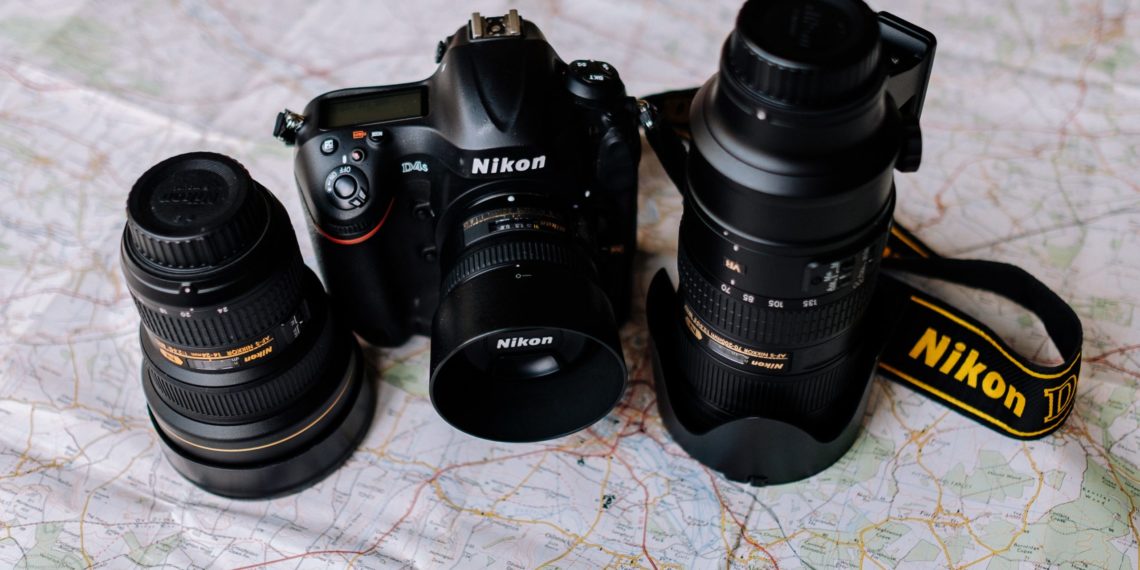
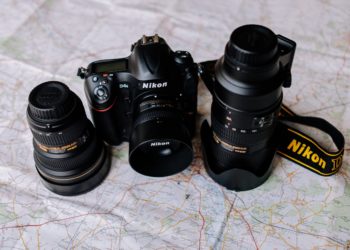
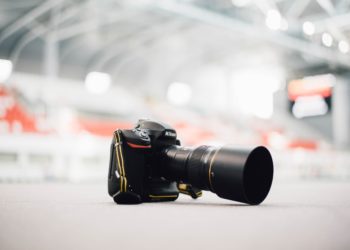




Discussion about this post